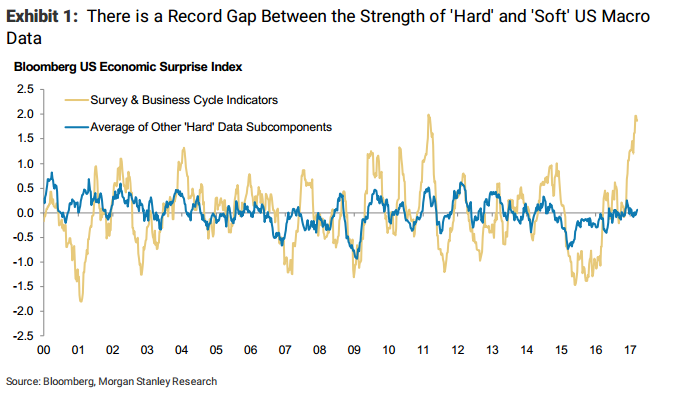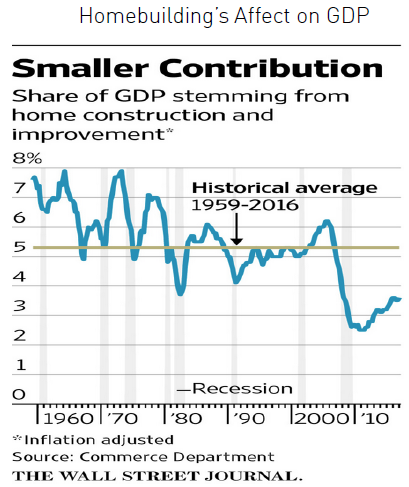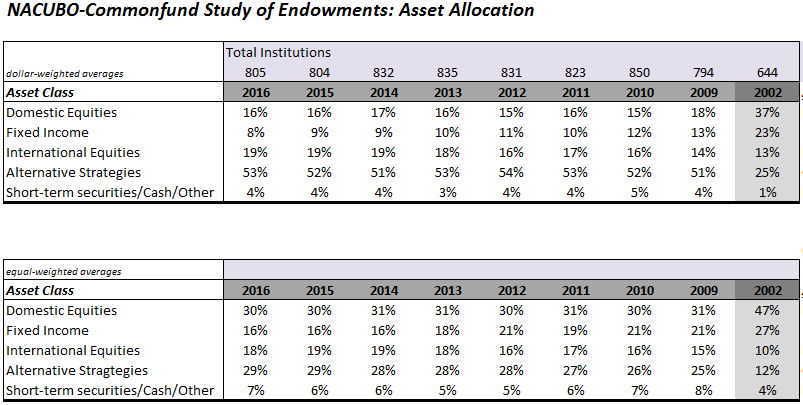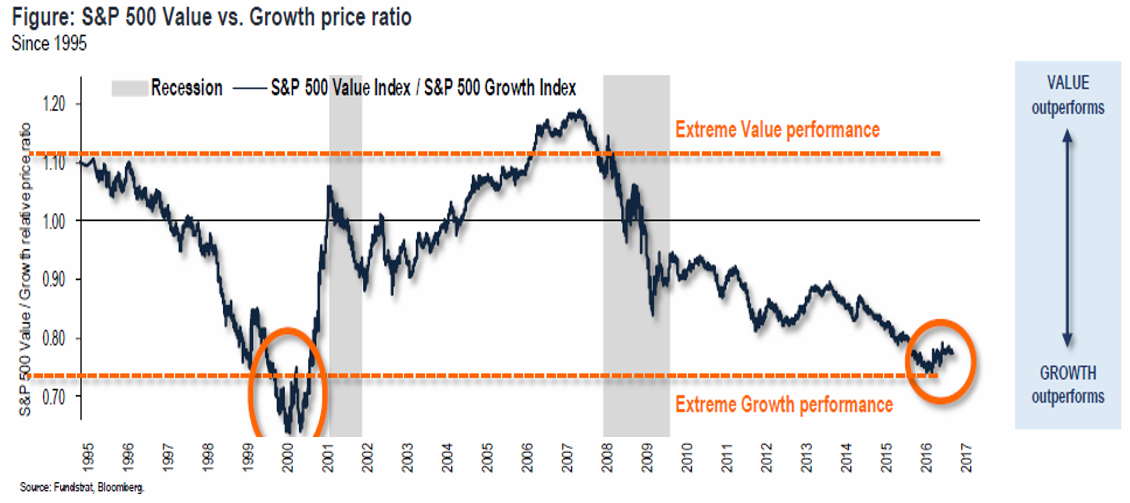by William Smead, Smead Capital Management
Like a good attorney, we rarely ask a question for which we don’t have the answer. In the case of looking at sentiment in the economy and in the stock market, we like watching to get a feel for what our professional and individual investor clients are going through to see if it matches what we are hearing and seeing. The bifurcation in the economic sentiment surveys is that sentiment and confidence in economic growth are high, but those enthusiasms have yet to show up in real Gross Domestic Product (GDP) growth.

Source: http://www.valuewalk.com/2017/04/economic-data-hard-data-soft-data/
There appears to be two possible outcomes from the divergence between economic hopes and, on the ground, economic growth. The first possibility is that we continue to muddle along with anemic economic growth of 1 to 2%, and make the sentiment appear like a false signal, akin to prior spats of enthusiasm. Or, alternatively, the shift in U.S. demographics and significantly higher household formation may begin to positively impact economic growth. How can a logical person be positive about economic growth over the next ten years?
To be positive on economic growth you must believe that experts have significantly underestimated the negative impact home building has had over the last eight years. Here is how Ivy Zelman, a highly thought of housing analyst, explained these circumstances to Barron’s in 2016:
This cycle will be elongated, and the slope of the recovery is flatter than what we thought the trajectory would look like when we called the bottom in 2012. Builders have been slower to see the growth. There’s a shortage of shelter. We’re pretty indifferent whether shelter should be owned or rented. We’re just saying there isn’t enough. The U.S. is at a 30-year low of inventory available for sale. We are predicting double-digit housing-starts growth this year, next year, and in 2018.1

Wouldn’t experts be likely to underestimate its positive affect going forward? The difference between past economic recoveries and today’s recovery is the contribution made by home construction and improvement. Could the engagement of 25 to 35-year old Americans in the housing market be causing confidence in the future, but not yet show up in the GDP statistics? In a report on CNBC, April 24, 2017, Diana Olick reported the following:
Even as more homes come on the market for this traditionally popular sales season, they’re flying off fast, with bidding wars par for the course. Home prices have now surpassed their last peak, and at the entry level, where demand is highest, sellers are firmly in the driver’s seat.“I’ve been selling real estate for 25 years and this is the strongest seller’s market I have ever seen in my entire real estate career,” said David Fogg, a real estate agent with Keller Williams in Burbank, California.2
A second strange bifurcation exits today in stock market sentiment, as the individual investors are extremely bearish and the professionals are uncomfortably bullish. Here is the latest weekly reading from the most popular sentiment surveys (American Association of Individual Investors and the Investors Intelligence Poll of Professional Newsletter Writers):

51.9% Bulls
18.3% Bears
A few caveats before we analyze this information. First, to the long duration owner of common stocks, market timing is useless in our opinion. If you endeavor to own wonderful companies for a long time, big market declines are only useful for the doors they open in presenting bargains to the “high margin of safety” investor.
Second, sentiment is usually the most beneficial at extremes and requires standing against a crowd. As contrarians, we like the reinforcement of those bouts of fear (buying opportunities) and euphoria (round up the wagons time). Warren Buffett says, “Be fearful when others are greedy and greedy when others are fearful.”
There are several possibilities for this episode of divergent stock market sentiment readings. Here are a few of our favorites:
-
- 1. Professional investors are the least directly involved in the stock market in decades. The chart below shows that major institutional investors (as represented by endowments and foundations) have dramatically reduced ownership of U.S. stocks in their portfolio.

Source: NACUBO-Commonfund Study of Endowments, Data for the period 1/1/2002-12/31/2016.
-
- 2. Professional investors have emphasized indexing and removed individual stocks from their portfolio. In the process of being heavy venture capital investors (within their alternative strategies) and big indexers, they over-own glamour technology stocks and carry the corresponding bullishness that goes with the tech sector today.

Source: http://www.marketwatch.com/story/how-can-active-fund-management-be-dead-if-
indexing-represents-only-5-of-all-assets-2017-01-13. Data for the period 1/1/2007-11/30/2016.
- 3. Individuals have clear and powerful memories of the 2007-2009 bear market, the financial meltdown, and the fallout it caused. Anything which harkens individual investors back to that nightmare decline in prices causes their confidence to drop and leads some to run for the exits quickly.
Could there be a connection between the bifurcations in economic sentiment and stock market sentiment? We believe there could be. If the economy is stronger the next five to ten years, Main Street could outperform Wall Street. Home building is underrepresented in the S&P 500 Index, as are numerous Main Street industries which feed off housing development and building activity. Think of what could happen to incomes in trades like carpentry, electrical contracting, and plumbing.
Value-based stock picking could have a season in the sun after eight years in the doghouse. This could come in the context of poor to mediocre index performance and justify bullishness among investors in meritorious stocks and value-based strategies.

Source: Fundstrat Fall 2016 “State of the Market”, page 72. Data for the period 1/1/1995 – 3/31/2017.
We find great value today in the financials, consumer discretionary, and healthcare-related companies which meet our eight criteria for common stock selection. We believe they could be beneficiaries of better economic growth in the U.S. We also like the comfort of owning our businesses at prices well below the average of our primary index and of many peers. Lastly, our view of the future is never determined by sentiment surveys and economic predictions, because, in our observation, the only thing which is guaranteed in investing is that things will change.
Warm Regards,

William Smead
1Source: Barron’s
2Source: CNBC
The information contained in this missive represents Smead Capital Management’s opinions, and should not be construed as personalized or individualized investment advice and are subject to change. Past performance is no guarantee of future results. Bill Smead, CIO and CEO, wrote this article. It should not be assumed that investing in any securities mentioned above will or will not be profitable. Portfolio composition is subject to change at any time and references to specific securities, industries and sectors in this letter are not recommendations to purchase or sell any particular security. Current and future portfolio holdings are subject to risk. In preparing this document, SCM has relied upon and assumed, without independent verification, the accuracy and completeness of all information available from public sources. A list of all recommendations made by Smead Capital Management within the past twelve-month period is available upon request.
© 2017 Smead Capital Management, Inc. All rights reserved.
This Missive and others are available at www.smeadcap.com.
Copyright © Smead Capital Management













